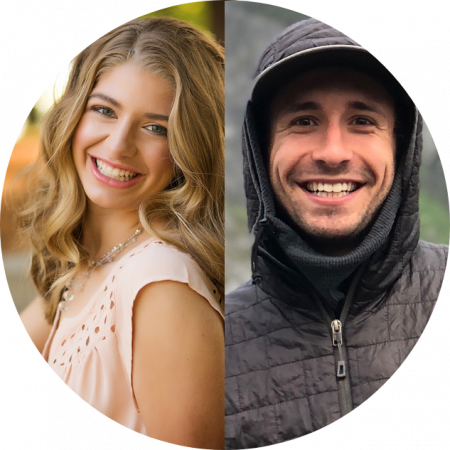Speakers: Becca Hanlin and Rob Heavner
Moderator: Victoria Docherty
Becca Hanlin is currently a master’s student in the International Education Policy Analysis (IEPA) program at Stanford Graduate School of Education. Hanlin is particularly interested in studying early childhood experiences, informed in large part by her time teaching in disadvantaged communities.
Rob Heavner is a master’s student in the Policy, Organization, and Leadership Studies (POLS) program at Stanford Graduate School of Education. Heavner received his B.A. in International Studies from Kenyon College. Before coming to Stanford, he served as a middle school humanities teacher and directed an outdoor education program.
Central questions:
- What courses have you taken this quarter and how do you feel about them? If they were in-person classes, what made them different or unique?
- What are some specific activities or examples of intentional community building that you have experienced?
- What was your thought process for starting Stanford and knowing that the quarter would be remote? What are your hopes and expectations for the Winter quarter?
- What other elements can you identify from your courses that you consider to be essential for remote learning?
Key quotes:
I really didn’t expect to make connections like on Zoom. I didn’t know what that would look like, but the connections were made. I feel like all of our voices were shared and we could hear one another, really well and get to know one another in that somewhat surprising way. – Rob Heavner (05:50)
In one class I had, we started every class by changing our Zoom names to respond to just a casual question that was asked like what’s your favorite music or what are you going to be for Halloween. These sorts of just very like fun chatty sort of questions, not related at all to the academics of the class. – Becca Hanlin (10:48)
I feel lucky to have made connections with people in my cohort and from other classes as well through group projects. I think there is something kind of unique and weird about this time where everyone is kit bonded through this experience and so I think people are very open to doing an extra Zoom call or talking on the phone or just get to know one another. – Rob Heavner (15:35)
One thing that really helped me was just the variety of activities that were offered during a class. We all at some point are experiencing fatigue, so being able to go into a class and having kind of different things to do instead of just sitting and kind of zoning out was really helpful for my engagement. – Becca Hanlin (19:27)
Takeaways:
Unique course experiences and in-person meetings
- Smaller cohorts allow instructors more opportunities to incorporate community-building activities and focus on student engagement
- Occasional in-person meetings and interactions with peers and professors provide for engaging and fun experiences
- Fluid discussions and conversations with the purpose of getting to know people on a more personal level help class time run more smoothly
- Safe space within Zoom for students to voice opinions and share ideas allow for deeper connections within the cohort and class
Examples of intentional community building
- Start each class with a community-building activity that asks students to work in pairs and share out as partners or have students change Zoom names to respond to questions that are not related to class
- Breakout rooms with small groups of students that work together on a variety of five to six icebreaker activities for every class
- Connect with students on a level that is not specifically about the course and offer to individually meet with students for one conversation, and provide various forms of communication (e.g., email, texting, phone call, Zoom meeting)
- Provide more community-building exercises that involve the instructor and TA to participate with the class
- On a Google slide, list three historical figures that would you bring to a dinner party and share out results
Hopes and expectations for the Winter quarter
- Instructors to try and adapt the curriculum to Zoom to provide more engaging experiences and intentional social connections
- Students to work on making connections with their cohort through group projects, sharing experiences, and being open to communication outside of class (e.g., phone call, Zoom meeting, messaging)
- General openness from students and teachers with a willingness to be more flexible and adaptable for class
- Everyone to be appreciative and accepting of the current situation with all of the potential mistakes and technical issues
Elements from courses that are essential for remote learning
- Smaller group work that allows students to be more responsible for connecting in class, more freedom to work on group assignments, and the option to discuss informally in breakout rooms
- Less lecturing for class and more hands-on discussion about creating deliverables to share out and guidance from instructors in breakout room sessions
- Variety of different activities for class to combat Zoom fatigue and promote student engagement
- Instructor’s openness and willingness to accept feedback to create positive experiences and an environment where students feel comfortable
- Google Form for student feedback including a pre-class survey to ask about student comfort levels and course expectations, and a mid-quarter survey to see how everything is going and what can be improved
